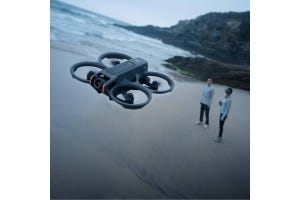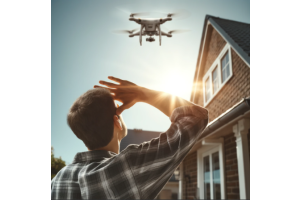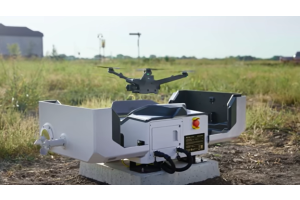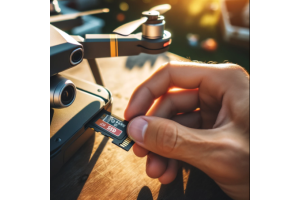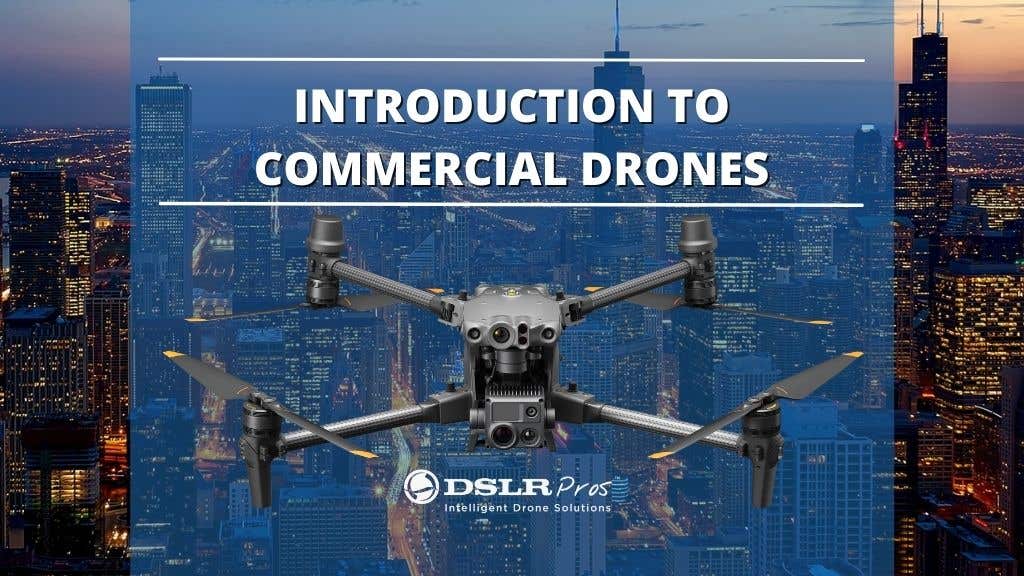
Commercial drones are becoming increasingly common in the United States. Although commercial drone technology has been around for years, its application was limited to only a few industries including agriculture and construction.
However, the introduction of new and innovative solutions in recent years has changed this landscape. Now, more than ever before, we are seeing an increase in demand for unmanned aerial systems (UAS) that can be used for various purposes such as surveillance, mapping, and even delivery services.
"The global unmanned aerial vehicle (UAV) market size was valued at $10.72 Bn in 2019 & is projected to reach $25.13 Bn by 2027, with a CAGR of 12.23% during the forecast period." Source - Fortune Business Insights.
Going by the above forecast, it's pretty clear that the commercial drone industry is about to explode.
But just what is it that's driving this phenomenal growth? What are the applications of commercial drones and how are they helping businesses of all sizes to save money and time?
Let's find out.
What Are Commercial Drones?
Commercial drones, also known as unmanned aerial vehicles (UAVs), are aircraft that are used for business and industrial purposes. These aircraft are sophisticated in function and are well equipped to handle complex tasks. Drones are remotely controlled from the ground by trained and professional pilots.
Unmanned aerial vehicles (UAVs) are a subset of Unmanned Aerial Systems (UAS)
Commercial Drone Applications
Commercial UAVs have come a long way since their early days of limited functionalities. As a result, several businesses, trades, and industries have readily embraced them to simplify their operational workflow. Here are some of the most notable applications of UAVs:
Public Safety
Drone programs have found plenty of positive impact on public safety operations because of their ability to save lives. As a life-saving tool, UAVs have been widely used in law enforcement, firefighting, search and rescue, and disaster response.
Law Enforcement


Dones have turned out to be an effective force multiplier in police work. They remove the necessity for police officers to expose themselves to high-risk situations like a hostage scenario, active shooter situation, or other dangerous situations. This has led to the development of new tactics and SOPs that include drones as a part of police operations.
Since drones can provide greater situation awareness, law enforcement agencies are better equipped to plan and strategize in order to minimize risks and maximize effectiveness.
Benefits of Using Commercial Drones In Law Enforcement Include:
- The live feed from a single drone can be shared with a central control station to allow for real-time data-driven action.
- Optical zoom functionality can allow for discreet surveillance from the sky
- Furthermore, drones can also be used to create accurate 2D and 3D maps and models of crime scenes
- Commercial drones with smart tracking features can be used to track a suspect on the run with ease and without the risk of pursuing on foot.
- Drones like the Matrice 200 V2 and the Matrice 300 can also use loudspeakers that allow police to communicate with subjects.
Firefighting


Commercial drones are also being increasingly used by firefighters. Drones have proved to be very effective in tracking and containing wildfires. Considering the scale and unpredictability of wildfires, it's almost impossible for firefighters to get a sense of the scale of the fire without having an extra pair of eyes in the sky. Equipped with thermal cameras and other sensors, an unmanned aircraft can give firefighters an overview of the terrain and predict a wildfires' likely course. This information can be utilized to cull the fire and also plan an evacuation if there are any people at risk.
Drones can also prevent wildfires by helping the fire department perform controlled burns to clear dry brush and vegetation from areas prone to wildfire. The US Forest Services has already experimented with dropping fireball ignites called "dragon eggs" using drones. These fires can be started efficiently without exposing firefighters to danger. Read the full story on this interesting innovation on this NGC page.
Benefits of Using Commercial Drones In Firefighting Include:
- Drones can provide a critical bird's eye view of the area to help coordinate movements between one or more firefighting teams.
- Drone thermal imaging capability can be used to "see" the hottest or the coolest spots in a blaze. This provides firefighting teams with actionable intel as to where they should focus their efforts.
- Visual sensors with powerful zoom capabilities such as the H20 can help monitor the blaze even at at a distance, reducing risks to personnel.
- Both optical and thermal payloads are invaluable tools for locating trapped or missing people in forest fires for example, where people may be surrounded by flames at all sides with no means of escape or communication.
- Firefighters can also use drones after the blaze to inspect burned out areas or structures that may be prone to collapse without endangering personnel.
Disaster Response + Search and Rescue


Natural disasters present a huge challenge for emergency responders. Drones can help reduce the amount of time spent searching for survivors and victims after a natural disaster occurs.
Search and rescue operations are inherently challenging. And in most cases, time is of the essence. A lot of resources are needed to look for survivors. Drones can play a big role in helping locate people quickly and efficiently without having to mobilize a huge ground force. Modern commercial drones come equipped with thermal imaging, GPS, and other sensors that allow them to gather information and locate people faster than traditional methods.
Benefits of Using Commercial Drones for Search and Rescue Include:
- In cases of disasters like earthquakes or landslides, drones fitted with thermal sensors can be deployed to find survivors buried under rubble by detecting their heat signatures. Their GPS coordinates can then be relayed to the ground crew.
- Thermal or infrared payloads are also incredibly helpful for conducting search and rescue operations even in zero or low-light conditions.
- During search and rescue operations, drones equipped with two-way communication systems can be used to talk to the victims and reassure that help is underway.
- Critical life-saving supplies like water, food and medical aid can also be delivered by drones equipped with a payload drop system.
Energy and Inspection


Energy companies are also frequently utilizing UAVs to perform inspections of power lines, pipelines, wind turbines, and solar panels. Companies are able to remotely check the health of their equipment without risking workers getting hurt.
Oil and gas companies often find assessing flare tips and floating points difficult. However, drones have solved the issue of accessing hard-to-reach locations. They are also used to inspect wells, pipelines, and offshore platforms.
Inspection of wind turbines is another area where UAVs are proving useful. With the rise of renewable energy sources, more and more wind farms are popping up across the globe. The problem is that the blades of wind turbines become worn over time and need to be inspected regularly. Without using drones, this process requires physically climbing and entering the turbine to collect data. That means a thorough inspection can be laborious, time-consuming and dangerous. Unintentional falls are a common safety concern for any inspection work conducted at height.
In contrast, using drones for turbine inspection means that personnel can use optical or thermal imaging to check on potential issues without the safety risks posed by manual, in-person inspections.
Similarly, solar energy companies are also harnessing the power of UAVs. For example, panel inspection can be done in record time with enterprise drones as compared to manual inspection.
Moreover, thermal drones with radiometric capabilities can detect thermal anomalies that may be otherwise invisible to the naked eye. Radiometric data collected by these drones contain precise temperate readings of solar module and cells - allowing operators to ensure that they're within safe temperature ranges.
Benefits of Using Commercial Drones for Energy and Inspection Include:
- Increased Safety
- Faster inspections
- Decreased Downtimes
- Cover More Ground in Less Time
- Faster Data Collection
Mining


Commercial drones are also being used extensively in the mining industry. They are used to conduct inspections of mining equipment, underground shafts, and tunnels. The use of drones is especially useful when conducting routine maintenance checks on machinery. It allows inspectors to access hard-to-reach places and inspect equipment that would otherwise require heavy equipment such as cranes and excavators.
Benefits of Using Commercial Drones for Mining Include:
- Being able to mount multiple cameras or sensors onto a highly mobile platform such as drones allow for quick yet accurate collection of mining data.
- Technologies like LiDAR can be used to map areas being mined.
- The mining data collected by drones in turn can translate to more effective mining operations management and better assessments of drilling and blasting activity.
- Enhancing safety by allowing inspections to be carried out remotely without sending in personnel to caved-in or otherwise dangerous areas.
- In addition, drones with methane detectors can detect leaks and help prevent uncontrolled explosions.
Agriculture


The agriculture industry is gradually warming up to the use of autonomous drones or UAVs in crop management. This includes monitoring crops, detecting pests, planting seeds, livestock management, and even spraying pesticides and fertilizers.
There are many reasons why farmers are embracing drone technology. First, it allows them to monitor crops from above instead of having to get on foot or drive out to the field. Second, it helps them save time and fuel costs because they don't have to travel long distances across huge swathes of land. Fifth, it increases productivity by allowing farmers to make better field management decisions based on accurate data.
Drones using multi-spectral payloads can capture changes in the light reflected by plants. While these changes aren't visible to the naked eye, the light reflected from plants can signal crop health issues well before our eyes can perceive them. Farmers using drones equipped with multi-spectral payloads are able to more proactively address issues with crop stress compared to farmers who may rely on the more traditional methods of inspecting crops.
Benefits of Using Commercial Drones for Agriculture Include:
- Lower Operating Costs
- Better Yield and Crop quality
- Proactive Crop and Soil Monitoring
- Save Crop Loss and Maximise Output
Surveying


Surveyors and GIS professionals have relied on conventional methods such as GPS, total stations, and ground laser technology to perform topographical surveys until recently. While these methods may have worked to get the job done, you can't really argue about the inefficiency and higher costs associated with these outdated methods.
Drones are already being used extensively in construction, architecture, engineering, and land surveying. But what if you could combine multiple types of drones? What if you could combine aerial photography with 3D mapping capabilities? Well, we can do exactly that - thanks to modern commercial UAVs that are equipped to perform photogrammetry - a very useful surveying method. They also allow surveyors to create high-quality 3D models of buildings and topographic maps of sites.
It's worth mentioning that Enterprise drones like Matrice 300 RTK have not only overhauled surveying but also made it more accurate, fast, and efficient. Most importantly, there's no need for surveyors to get into difficult situations and risk their safety. For example, if you were to use a hand-held GPS device, you would be required to climb up ladders, bridges, and other structures to take measurements. This could be dangerous as there's always a chance of accidents and falls. Drones, on the other hand, can completely eliminate this problem by allowing surveyors to remotely fly over sites without risking their safety on in-person inspections.
Benefits of Commercial Drones for Surveying
- Less Time Required to Gather Accurate Data for Faster Decision Making
- Eliminate Common Risks and Dangers Associated With Traditional Methods of Surveying
- Cost-effective
Insurance


Insurers use drones to determine the valuation of properties by gathering visual data. Visual inspection of a property is not only faster and cheaper than hiring inspectors but also safer since drones can fly over a property from any angle.
Roof damage inspections are particularly challenging for insurance inspectors because they have to not only climb the roof using a ladder but also inspect it thoroughly using a handheld camera while minding their safety. With drones, they don't need to worry about falls during inspections.
The insurance industry also uses UAVs to assess the damage caused by natural disasters such as hurricanes, tornadoes, earthquakes, floods, and wildfires. With the 360 visual data of property in hand, it's easier for insurers to calculate the amount of compensation required to rebuild damaged property. This data can be used for faster claim settlements and identifying fraudulent claims.
For fraud prevention, a drone could be deployed as soon as a property claim is reported (First Notice of Loss), increasing the accuracy and timeliness of information collection.
Benefits of Using Commercial Drones In Insurance
- Better evaluation and risk assessment
- Efficient claim management
- Fraud monitoring and prevention
- Improved Safety
Commercial Drone Payloads
A drone's payload is the extra weight it can carry. Typically, it is calculated separately from the weight of the drone and includes anything else the drone carries - like extra cameras, sensors, or packages to deliver. There are different payloads that can be attached to commercial UAVs. Some of which include:
- Thermal Imaging Cameras
- Infrared Cameras
- Laser Scanners
- GPS Receivers
- 3D Scanning Systems
- Light Detection & Ranging (LiDAR) Equipment
- Gimbal Spotlight
Things to Consider Before Buying A Commercial Drone


Most commercial drones come with a wide range of capabilities and features. Before you select one for your business, you should consider factors such as your use case or the task you intend to perform with it.
Besides that, some practical features to consider include:
Image quality
If you are going to be using a drone for commercial purposes, chances are you'd want the image to be of high quality. A higher resolution means better detail, which will help you capture videos and images that are clear and sharp enough to be used for various applications.
Flight time
Most commercial drones have an average flight time of 40 minutes. Consider if this is going to suffice for your needs.
Battery life
You don't want to spend hours waiting for your battery to charge. Make sure that you buy a drone with long battery life so that you won't have to replace batteries frequently. And if uninterrupted operations is crucial to your job, look for models that have hot-swappable batteries.
Range
You need to know how far away your target area is before you decide on the right model. For instance, if you're planning to use it for inspections of large areas, make sure that your drone has a decent transmission range.
Weight
Heavier drones tend to to consume more power and are more difficult to transport.
Cost
While drones can be a significant investments, their many benefits to efficiency, data collection, and especially safety will help you save on costs in the long run.
Safety
It goes without saying that safety is always paramount. When flying a drone, you must ensure that you follow all rules and regulations set by the FAA or the regulatory body that covers your jurisdiction
Size
For some use cases, the size of the drone can be of importance. For example, if your job requires you to fly the drone tight areas, you may want to consider a smaller drone.
Flight Performance
As a drone pilot, you might want to consider the in-flight performance before going for a particular model. Factors include propeller thrust characteristics, maneuverability, flight envelope, and cruise performance.
Most Popular Commercial Drones
The drone market is growing rapidly and there are many drone companies offering cutting-edge commercial UAVs. Here's our recommend list of some of the best drone models in the commercial market today.
Matrice 30


DJI's Matrice 30 backpack drone is the company's newest flagship model. For a better flight experience, it has a single camera payload with several high-performance sensors, a new remote control, and enhanced Pilot 2 software. The M30's small size makes it perfect for easy transport and setup.
The M30 and M30T are the two variations of the M30 series. The M30 has a 48MP 1/2" CMOS zoom camera with 5x-16x zoom and 200x digital zoom. The M30 also has an 8K photo resolution, 4K/30fps video resolution, and a laser rangefinder that can pinpoint the exact location of objects up to 1,200 meters away. The M30T comes with all of the functionality of the M30, plus a 640x512 radiometric thermal camera.
The M30 can endure severe rain and temperatures as low as -20°C and as high as 50°C thanks to its IP55 rating.
A new low-light first-person pilot camera, built-in redundancy and backup processes, a three-propeller emergency landing system, a Health Management System, and six-way collision avoidance sensors are also included.
The DJI M30 is foldable, lightweight (3.7 kg take-off weight), and highly portable, which sets it apart from many other commercial drones.
A 41-minute flight time is possible with this UAS with the aid of the new self-heating TB30 battery.
Its clever BS30 charging case takes roughly thirty minutes to charge the battery from 20% to 90%.
The M30 also has a self-locking system and can be folded with a single button, making it the quickest and easiest drone in the DJI Enterprise line to set up.
Matrice 300 RTK


The M300 RTK is undoubtedly a beast in the enterprise drone space. Notable features of this drone include 55 minutes of flight time, six directional obstacle sensing, and the ability to carry multiple payloads, there's no doubt why this drone is one of the most popular choices among businesses.
With the right payload, this versatile UAV can be put to good use in almost any commercial application including law enforcement, fire fighting and search and rescue, and industrial inspections. Additional standout features of the M300 RTK include the ability to swap batteries without turning the drone off (hot swapping), dual pilot mode, and smart tracking capability that allows the drone to identify and follow moving subjects like people or vehicles. In addition, this drone's IP45 rating means it can fly even in less than ideal weather conditions.
Mavic 2 Enterprise Advanced


The Mavic 2 Enterprise Advanced leaves almost nothing to be desired in an enterprise drone. With its 32X zoom, video capture resolution of 3840×2160@30fps and a thermal resolution of 640*512, flight times of more than 30 minutes, the M2EA is one of the most advanced thermal drones to hit the market. This drone is a powerful asset to public safety and inspection use cases, given the importance of thermal imaging in those scenarios.
Brinc Lemur s


The Brinc Lemur S a rugged, tough drone created specifically for the needs of law enforcement agencies. Its glass breaker allows it to breach and enter vehicles and structures without endangering law enforcement personnel. Its onboard microphone and speakers allow for two way communication through the Lemur S - making it a valuable tool for hostage negotiations. This UAV also features a LiDAR based navigation system that allows it to effectively navigate indoor environments. A perch time of 10 hours makes the Brinc Lemur S a great asset for extended missions.
Autel Evo II Dual R


The Autel EVO II Dual R is a formidable contender to DJI Mavic series. It's a compact yet powerful workhorse that can perform a wide range of tasks from aerial inspection to mapping and surveying. The Evo II Dual R features 8K optical video capture paired with a FLIR Boson 640x512 radiometric thermal imaging camera - allowing it to record per-pixel temperature data for analysis. A lack of geo-fencing sets this drone apart from DJI drones - a critical advantage especially for search and rescue operations where rapid deployment is crucial.
What You Need To Know About FAA Compliance
The Federal Aviation Administration (FAA) has outlined a number of regulations that govern the use of commercial and consumer UAVs. Before you get started flying, it would serve you well to be familiar with the rules and regulations.
In America, commercial drone use is governed by the FAA's Part 107 rules. It requires commercial drone pilots to get certified and licensed and refrain from flying at night or in controlled airspace without permission. To know more about these rules, check out this page.
Commercial Drone Experts


Our team at DSLRPros has worked with private businesses as well as federal agencies for more many years. We understood how critical it is to find the best drone for your needs right from the start. That's why we offer a free no-obligation consultation to help you make the right decision. Click here to contact your drone program consultant today!

